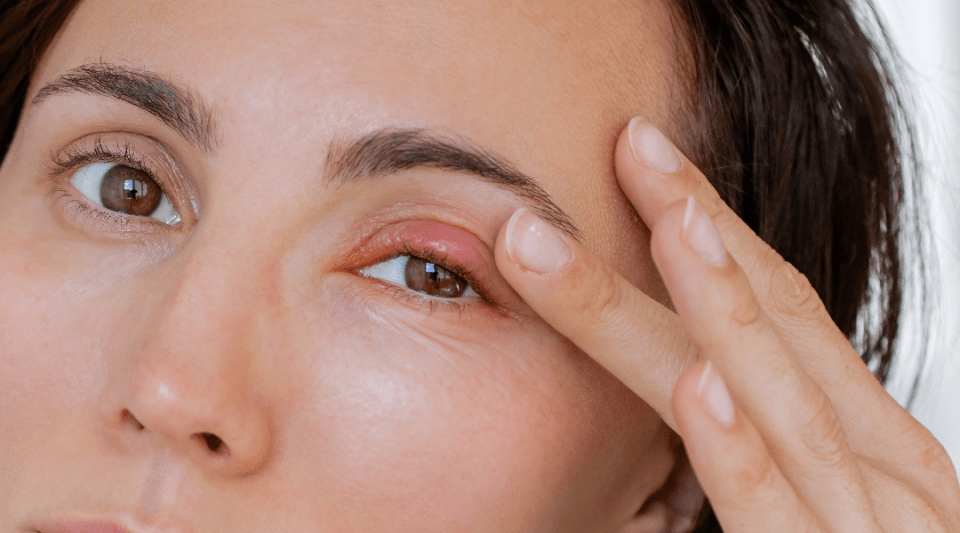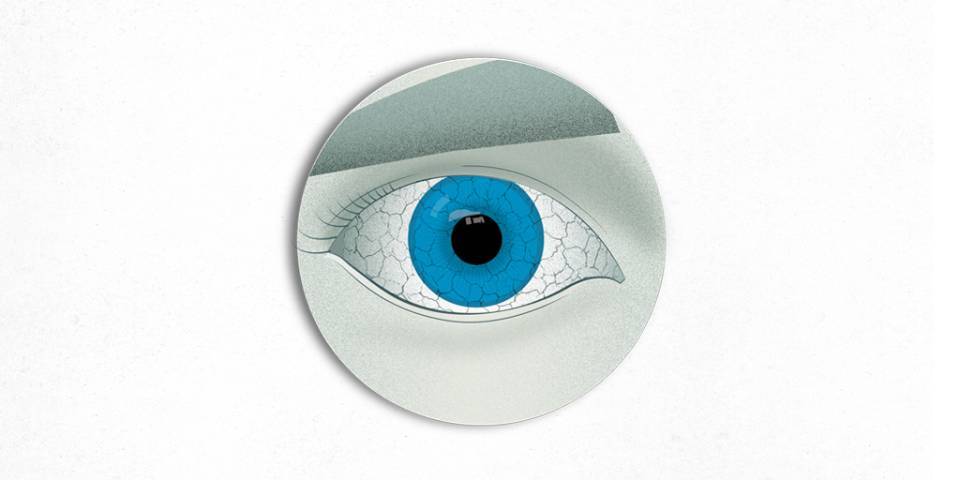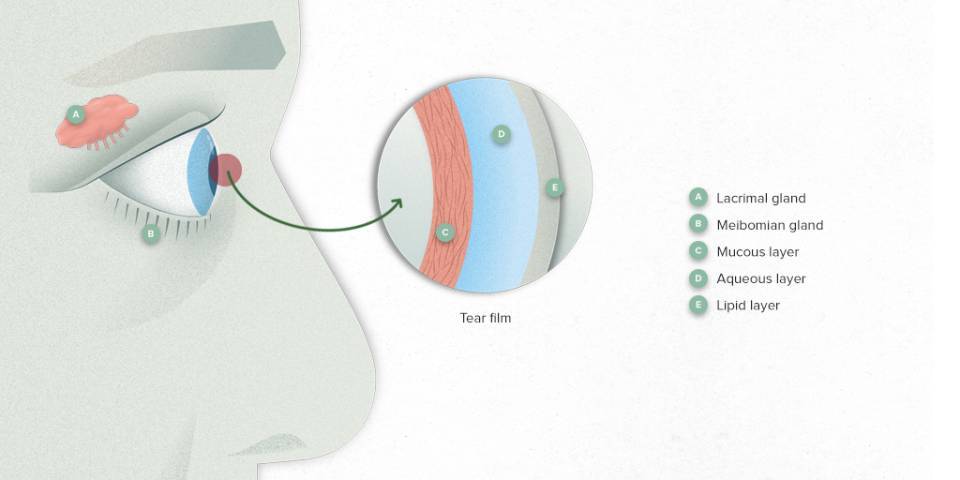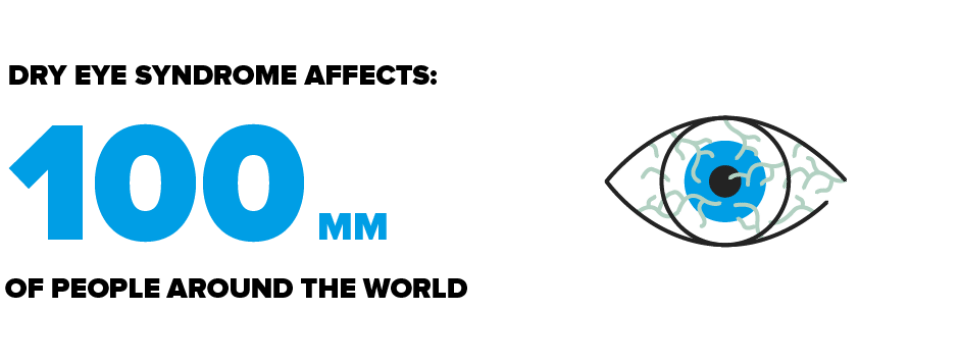- What is it?
- Risk factors
- Symptoms
- Diagnosis
- Treatment
- Living with the disease
- Research
- Frequently asked questions
-
La enfermedad en el Clínic
- Equipo y estructura
What is the dry eye syndrome?
Dry eye syndrome is a disease caused by a disorder of the tear film, either due to a deficiency in tear production (aqueous-deficient) or due to excessive evaporation (evaporative) that consists of inflammation of the eye surface and neurosensory changes that lead to eye discomforts. It is an under-diagnosed disease as patients with mild dry eye do not go to a specialist. It is estimated that there are around 100 million people worldwide affected by this disease.
Dry Eye Syndrome explained in first person
It is a chronic disorder that is going to need treatment, depending on the severity, this treatment will be more or less thorough. When the treatment is sufficient and adequate, the patient will not have any symptoms.
I knew at the start that it was going to be so hard, but the treatment works. It’s true that it’s long-term, and that you need to give it a chance and be very consistent and not stop, not even for one day, but it works. To the point that you can return to a pretty normal life.
Dry eye is a multifactorial disease noted for alterations in the tear film that cause eye discomforts and changes in vision. This disease is accompanied by an increase in osmolality (total concentration, measurement is osmoles per litre, of a substance in a solution) of the tear film, inflammation of the eye surface and neurosensory changes.
Mechanisms of the disease
Dry eye syndrome is understood as a loss of the homeostatic mechanism (dynamic equilibrium in the functions and composition of fluids and tissues) of the so-called Lacrimal Functional Unit (LFU). The LFU is formed by all the components of the eye surface (conjunctiva, corneal epithelium, Meibomian glands, and tear), the static and dynamics of the eyelids, the tear glands, and the neural network (afferent pathway, efferent pathway – sympathetic and parasympathetic).
The LFU controls and regulates the main components of the tear gland. It can be altered by external or environmental factors (low humidity, wind, work conditions, toxins), infections, or trauma (including surgery of the cornea), as well as internal factors, such as inflammatory diseases that affect the supporting tissues, due to alterations in the Meibomian glands or in the eyelid dynamics, due to changes associated with innervation, either at central or peripheral level, or due to the side-effects of drugs.
Its function is to preserve the integrity of the lacrimal film, the transparency of the cornea, and the quality of the image that is projected in the retina.
Tear film
The tear film is made up of water, fatty oils and mucin that are divided into three layers:
- The aqueous layer is the largest. It consists of almost 100% water. Its function is to protect the eye from infections, to lubricate it, clean it of small particles, and supply oxygen and nutrients to the cornea.
- The lipid layer consists of the Meibomian glands, which are the principal lipid source of the tear film, and it serves to prevent the evaporation of the aqueous layer situated behind. It acts as a lubricant between the eyelids and the cornea.
- The mucus layer is the most internal and keeps the eye humid and lubricated by distributing the aqueous layer on the eye surface.
The alteration of this LFU produces an unstable tear film that leads to hyperosmolality of the tear (high tear concentration with little fluid, either due to lack of tear production or due to an increase in the evaporation) and inflammation of the eye surface, which causes the signs and symptoms of dry eye.
The symptoms appear due to the hyperosmolality that stimulates a cascade of inflammatory events in the superficial epithelial cells which causes the death of these cells. The visual changes appear due to the irregularity of the tear film over the eye surface. The signs (superficial punctate keratitis, filamentary keratitis, etc.), are secondary to the rubbing of the eyelids with the eye surface.
Classification of Dry Eye Syndrome

Aqueous tear-deficient dry eye. Is produced due to a lack of tear production.
- Primary or secondary Sjögren syndrome. Primary Sjögren syndrome is a systemic disease that is noted for an autoimmune destruction of the exocrine glands of the whole body. The organs most affected are the eyes, the gastrointestinal system, the respiratory system, the skin, and the genitourinary system. It is diagnosed by the presence of dry eye combined with a dry mouth, by the presence of certain antibodies, a reduction in the salivary secretion and by the focal inflammation in a salivary gland biopsy. Secondary Sjögren syndrome has the same characteristics as primary Sjögren syndrome, but it is combined to the presence of another autoimmune disease such as rheumatoid arthritis, systemic lupus erythematosus, scleroderma, dermatomyositis, mixed connective tissue disease, Hashimoto’s thyroiditis, primary biliary cirrhosis, or autoimmune chronic hepatitis.
- Without associated autoimmune disease. Due to an isolated lack of aqueous secretion of the tear gland, or as a secondary effect to other systemic medications such as anti-histamines, beta-blockers, antidepressants, tranquilisers, etc.

Evaporative dry eye. It appears due to the excessive loss of water of the exposed eye surface (due to evaporation).
- Diseases of the Meibomian glands (rosacea, psoriasis, seborrheic dermatitis, etc.). The Meibomian glands found in the eyelid tarsi are the main source of the lipids of the tears.
- Changes in the eyelids or the lacrimal aperture [Seventh cranial nerve paralysis, proptosis (forward displacement of the eyeball)] due to hyperthyroidism, low frequency of blinking, etc.
- Vitamin A deficiency, interaction with topical medicine preservatives, changes due to contact lenses, allergic conjunctivitis.
Evaporative dry eye is more common than dry eye due to lack of aqueous secretion, although on many occasions both types are superimposed and there is simply a preponderance of one over the other.
How many people are affected by Dry Eye?
Dry eye syndrome is a very common disease, although in many casesunderdiagnosed. Its prevalence varies between 20% and 30% of the population, although it could rise to 33% in oriental populations. According to some estimates, around 100 million people worldwide have this disease. It is much more frequent in women, and increases with age.
Substantiated information by:

Published: 23 May 2019
Updated: 12 May 2025
Subscribe
Receive the latest updates related to this content.
(*) Mandatory fields
Thank you for subscribing!
If this is the first time you subscribe you will receive a confirmation email, check your inbox
Dry Eye Syndrome related news

30 November 2023
What are the most common eyelid diseases?

16 October 2023



